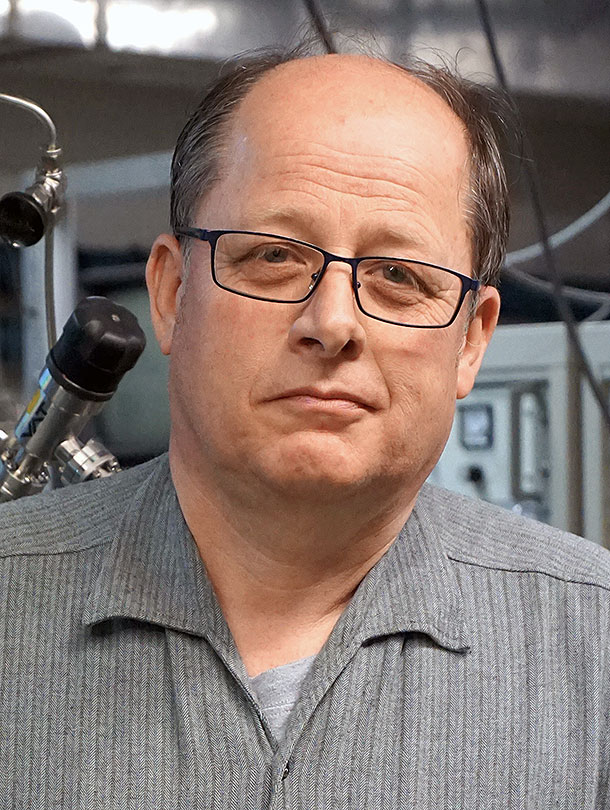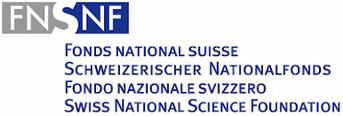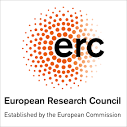Ernst Meyer
|
Head of the Group office 3.01 tel +41 (0)61 207 3724 more... |
 |
Teaching
Details about past, present and future lectures and courses can be found in the teaching section.
Research projects

Swiss National Science Foundation:
New Insight into Tip-Sample Interactions by Scanning Probe Microscopy (200021_175501)
This research proposal focuses on the progress in the study of local interactions by Scanning Probe Methods (SPM).
The research in this field is only possible due to our longstanding experience and equipment:
Nanolino: STM/AFM force microscopy in ultrahigh vacuum
LT-SPM: Combined low temperature scanning tunneling and force microscopy
The following research topics will be addressed in this period:
a) High resolution tunneling and force spectroscopy of Majorana bound states
From our recent experience in building atomic chains of iron atoms on superconducting
lead, our aim is to expand the investigations of the Majorana bound state (MBS) properties
such as the dependence of its wave-function as a function of the chain length. From
theory, it is expected that MBS are localized at the chain ends but tend to hybridize for
critical chain sizes ( < 20 nm), while for longer wires they should have clearly separated
states from the continuum. A second strand of research is related to the unexpected force
contrast suspected to arise from the bound state. Finally, we will also start manipulation
experiments of single-atoms on superconductors to control atom-by-atom built-up of 1D
and 2D structures to explore the interplay between the chain structure and the Majorana
wave functions or the non-Abelian properties of MBS.
b) Opto-Electronic properties at molecular scale
To electrically decouple the donor-acceptor (DA) molecules experiments will be performed
on thin insulating films of NaCl on metal substrates. However, there is first evidence that a
particular adsorption site of the molecule allows to form a chelate complex with a single
alkali atom pulled out from the decoupling layer leading to a change of the intra-molecular
charge distribution. Furthermore, we plan single-molecule manipulations to investigate the
influence of the adsorption site. In the second research period, we are going to measure
the charge distribution of the DA molecules in dependence of the optical excitation
(intensity, wavelength) by bias spectroscopy to investigate the intramolecular charge
distribution. An extended strand to be explored are molecular wires, which incorporate a
DA complex. These molecular wires will be lifted by the action of the probing tip to further
decouple them from the substrate.
c) Frictional and Contact Forces – Towards On-Surface Chemistry
We are aiming to use high-resolution AFM to resolve the hydrogen atoms and interactions
in configurations of three dimensional hydrocarbons based on propellane derivatives.
Though hydrogen bonding is a rather weak interaction, we are optimistic to detect these
forces in the topmost located hydrogen atoms. In addition to these experiments, we plan to
further extend our studies of frictional forces already explored for the graphene
nanoribbons. An advanced polymeric wire is a pyrene chain which has more degrees of
freedom. The plan is to pull theses pyrene chains along the Au(111) surface as for the
ribbon case. Since the additional flexibility might influence the frictional process, we expect
to observe the influence of these rotations in the force contrast. The experiments will be
compared to molecular dynamics simulations to further explain the force spectroscopic
data.

ERC-Advanced Grant (2019-2024):
Ultra-sensitive mechanical dissipation in classical, quantum and non-equilibrium nanocontacts
(ULTRADISS)
The area, and where we stand. Nanomechanical dissipation, experienced by tip-based AFM instruments,
provides an innovative source of information about the physics of materials, solids, surfaces and
confined fluids – while contributing at the same time to the progress of tribology. I and my collaborators
have made, in the course of the last decades, well-recognized experimental and conceptual advances by
exploiting and adapting advanced Atomic Force Microscopy (AFM) techniques, especially the
ultra-sensitive p-AFM , (dissipation sensitivity ~0.1 aW, force sensitivity ~ 10-12N)
addressing collective phenomena and
phase transitions including structural, electronic, magnetic in what could be broadly called dissipation
spectroscopy. A common tract of that past work has been so far to address systems that are mainly in
thermal and electrical equilibrium, mostly 3D classical ones.
The challenge. As permitted by our extreme sensitivity, it is now possible and desirable to extend
dissipation spectroscopy at the nanoscale to detect changes caused by non-equilibrium perturbations, by
nanomanipulations, and by switching quantum effects on and off. What could be the most promising
candidate systems for our studies? For non-equilibrium state dissipation and quantum dissipation effects
alike we must enhance focus within the sensitive region, the tip-sample nanocontact point, a purpose
better served by systems of reduced dimensionality, where nanomanipulation naturally also belongs.
The three subprojects: Quantum and classical non-equilibrium problems, as well as
nanomanipulation-motivated themes, all out of reach so far, will be part of our proposed nanomechanical
dissipation and force problem palette. That will range from thermophoretic phenomena on graphene (2D,
classical) and current-induced mechanical dissipation (1D and 2D, quantum), to manipulating graphene
nanoribbons and twisted bilayers (1/2D, classical), to mechanical dissipation at surface Kondo impurities
(0D, quantum) and at topological surface state (1/2D, quantum).
The potential relevance. Curiosity driven as they are, these studies also develop elements of potential
echnological relevance. Thermal and electrical phoresis are at the origin of migration of defects and
impurities, quite important in materials, and in electrical contacts. The rheological, mechanical, and
frictional parameters of 2D materials under nanomanipulation is basic for the assessment and stability of
all 2D-based devices, generally deposited and subjected to strains, shears, and gradients. Quantum
dissipation phenomena are currently under strong focus, their parameters representing one strong and
poorly explored limiting factor of all quantum information.
Other projects:
NFP 72: Fast Assessment of antibiotic resistance in bacteria by using nanomechanical arrays (407240_177354)
R’Equip: Low Temperature Scanning Probe Microscopy to detect Majorana fermions and magnetic molecules on topological insulators (206021_177021)
Sino-Swiss Project: Superlubricity from Macro- to Nanoscale: Bridging the gap between macro- and nanotribology (IZLCZ2_170212)
Publications
Latest Papers (show all)
| Velocity Dependence of Moire Friction Y. Song, X. Gao, A. Hinaut, S. Scherb, S. Huang, Th. Glatzel, O. Hod, M. Urbakh, and E. Meyer Nano Lett., 22, (23), (2022), 9529-9536, pdf. |
| On-Surface Synthesis of Unsaturated Hydrocarbon Chains through C-S Activation L. Giovanelli, R. Pawlak, F. Hussein, O. MacLean, F. Rosei, W. Song, C. Pigot, F. Dumur, D. Gigmes, Y. Ksari, F. Bondino, E. Magnano, E. Meyer, S. Clair Chem. Eur. J., 28, (2022), e2022008, pdf. |
| Proximity-Induced Superconductivity in Atomically Precise Nanographene. J.-C. Liu, R. Pawlak, X. Wang, P. D Astolfo, C. Drechsel, P. Zhou, S. Decurtins, U. Aschaeur, S.-X. Liu, W. Wulfhekel, E. Meyer. arXiv, (2022), pdf. |
| Flexible Superlubricity Unveiled in Sidewinding Motion of Individual Polymeric Chains J.G. Vilhena, R. Pawlak, P. D Astolfo, X. Liu, E. Gnecco, M. Kisiel, T. Glatzel, R. Perez, R. Haner, S. Decurtins, A. Baratoff, G. Prampolini, S.-X. Liu, E. Meyer Phys. Rev. Lett., 128, (2022), 216102, pdf. |
Latest Talks (show all)
| Controlled charging of self-assembled molecules on superconducting lead C. Drechsel , P. DAstolfo, X. Liu, S.-X- Liu, S. Decurtins, R. Pawlak, and E. Meyer ICSPM28, 2020-12-11, virtual, (Japan), Abstract (PDF). |
| Dye Molecules Studied by Scanning Probe Microscopy Th. Glatzel R. Jöhr, S. Freund, T. Meier, A. Hinaut, R. Pawlak, A. Sadeghi, S. Goedecker, S. Decurtins, S.-X. Liu, E. Constable, C. Housecroft, E. Meyer, and ICMAB â Seminar, 2019-09-20, Barcelona, (Spain). |
| Nanoscale analysis for energy materials Th. Glatzel and E. Meyer EMPA - Laboratory for Thin Films & Photovoltaics, 2019-08-08, Dübendorf, (Switzerland). |
| Decoupling of graphene by KBr intercalation on Cu(111) Th. Glatzel M. Schulzendorf, A. Hinaut, M. Kisiel, R. Jöhr, R. Pawlak, P. Restuccia, E. Meyer, M.C. Righi, and 22nd International Conference on Non-contact Atomic Force Microscopy, 2019-07-30, Regensburg, (Germany), Abstract (PDF). |
Latest Poster (show all)
| Tuning the work function and friction properties of KBr on Ir(111) by intercalating a monolayer of graphene Z. Liu, A. Hinaut, T. Glatzel, S. Scherb, J.Y. Zhang, and E. Meyer 2nd International Workshop on Superlubricity at Nano and Mesoscales, 2019-10-15, Shenzhen, (China). |
| Two-dimensional supramolecular networks formed by intermolecular interdigitation S. Scherb, A. Hinaut, R. Pawlak, J.G. Vilhena, Y. Liu, S. Freund, Z. Liu, X. Feng, K. Müllen, Th. Glatzel, A. Narita, and E. Meyer Symposium Chirality @ The Nanoscale , 2019-10-14, Ascona, (Switzerland), Abstract (PDF). |
| Large thermal expansion of a 2D supramolecular assembly S. Scherb, A. Hinaut, J.G. Vilhena, R. Pawlak, Y. Liu, K. Müllen, Th. Glatzel, A. Narita, and E. Meyer ncAFM 2019, 2019-07-30, Regensburg, (Germany), Abstract (PDF). |
| Dye Molecules on NiO(001) Studied by Non-Contact Atomic Force Microscopy Th. Glatzel S. Freund, A. Hinaut, E.C. Constable, E. Meyer , C. Housecroft, and 14th International Symposium on Functional Ï-Electron Systems, 2019-07-02, Berlin, (Germany), Abstract (PDF). |
